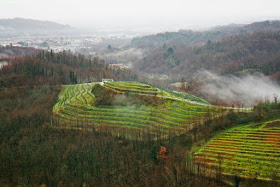As we're coming
into the end of 2015 and hopefully a great year for many we will be
starting off 2016 with our Italian Food, Wine & Travel group
(#ItalianFWT) featuring some of the lesser explored regions of Italy
starting with Basilicata.
Where is the
Basilicata region you say? It's bordered by Campania to the north,
Puglia to the east and Calabria to the south. It also touches the
coastlines of the Ionian Sea, Adriatic Sea and a touch of the
Tyrrhenian Sea. It's 2 provinces include Matera (a UNESCO World
Heritage Site) and Potenza. It is one of the more mountainous
regions of Italy and the south and equally as hilly. Basilicata is a
rather chilly region with the winds of the various seas helping to
mitigate the climate.
 |
| Matera by Martin de Lusenet |
The food of Basilicata
Although most of
the south is more seafood and fish based, this here is a mountainous
region so it focuses more on heartier fare including meats like lamb
and pork. The citizens of Basilicata also like their food with a
little pep so peperoncini here are popular in many dishes along with
dried sausages. You'll also find your typically staples of pasta,
bread and cheese since the foods of this region are more of a poor
man's cuisine.
 |
| Peperoncini by Francesco Cirigliano |
The wine of Basilicata
There are a few
volcanos in the Basilicata, but the one to make note of is Volcano
Monte Vulture. This volcano is one of the major influences on the
wine produced in the Basilicata in the northern part. The wines
produced in this area are the Aglianico del Vulture, which is also
known as the Barolo of the south produced from the aglianico grape
originally brought over by Greeks. This area also produces the only
DOCG of the region, Aglianico del Vulture Superiore DOCG.
 |
| Monte Vulture by Michael Nielsen |
Basilicata
actually has no native grapes like many of the other regions of
Italy. Although aglianico is the best known grape of the region, you
can find other grapes grown here including primitivo, cabernet
sauvignon, sangiovese, merlot, greco bianco and malvasia.
Our ItalianFWT
group has so much to share with you this Saturday, January 2nd
and you can join our online chat Saturday on Twitter at #ItalianFWT
11am EST to discuss all aspects of the Basilicata. We'd love to hear
from you if you have been here and can lend your knowledge so please
don't be shy.
Here is a preview
of my fellow bloggers for what is to come:
Vino Travels -Aglianico, What Makes Basilicata Pop!
Culinary
Adventures with Camilla - Calzone di Verdure and Grano
Dolce
Food
Wine Click – Basilicata Aglianico Eruption
Cooking Chat - Pasta with Bacon and Spinach
The Wining Hour - Basilicata Aglianico and Veal Osso Bucco
Cooking Chat - Pasta with Bacon and Spinach
The Wining Hour - Basilicata Aglianico and Veal Osso Bucco
Rockin Red Blog - In Step in Italy: Exploring Basilicata Wine
Girls Gotta Drink - Basilicata Traditions: A Cooking Class in Matera
Girls Gotta Drink - Basilicata Traditions: A Cooking Class in Matera






























